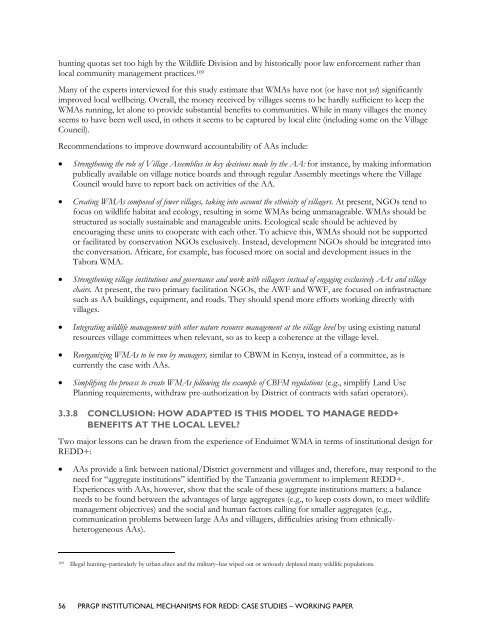Institutional Mechanisms for REDD+ - Case Studies Working Paper
Institutional Mechanisms for REDD+ - Case Studies Working Paper
Institutional Mechanisms for REDD+ - Case Studies Working Paper
You also want an ePaper? Increase the reach of your titles
YUMPU automatically turns print PDFs into web optimized ePapers that Google loves.
hunting quotas set too high by the Wildlife Division and by historically poor law en<strong>for</strong>cement rather than<br />
local community management practices. 109<br />
Many of the experts interviewed <strong>for</strong> this study estimate that WMAs have not (or have not yet) significantly<br />
improved local wellbeing. Overall, the money received by villages seems to be hardly sufficient to keep the<br />
WMAs running, let alone to provide substantial benefits to communities. While in many villages the money<br />
seems to have been well used, in others it seems to be captured by local elite (including some on the Village<br />
Council).<br />
Recommendations to improve downward accountability of AAs include:<br />
� Strengthening the role of Village Assemblies in key decisions made by the AA: <strong>for</strong> instance, by making in<strong>for</strong>mation<br />
publically available on village notice boards and through regular Assembly meetings where the Village<br />
Council would have to report back on activities of the AA.<br />
� Creating WMAs composed of fewer villages, taking into account the ethnicity of villagers. At present, NGOs tend to<br />
focus on wildlife habitat and ecology, resulting in some WMAs being unmanageable. WMAs should be<br />
structured as socially sustainable and manageable units. Ecological scale should be achieved by<br />
encouraging these units to cooperate with each other. To achieve this, WMAs should not be supported<br />
or facilitated by conservation NGOs exclusively. Instead, development NGOs should be integrated into<br />
the conversation. Africare, <strong>for</strong> example, has focused more on social and development issues in the<br />
Tabora WMA.<br />
� Strengthening village institutions and governance and work with villagers instead of engaging exclusively AAs and village<br />
chairs. At present, the two primary facilitation NGOs, the AWF and WWF, are focused on infrastructure<br />
such as AA buildings, equipment, and roads. They should spend more ef<strong>for</strong>ts working directly with<br />
villages.<br />
� Integrating wildlife management with other nature resource management at the village level by using existing natural<br />
resources village committees when relevant, so as to keep a coherence at the village level.<br />
� Reorganizing WMAs to be run by managers, similar to CBWM in Kenya, instead of a committee, as is<br />
currently the case with AAs.<br />
� Simplifying the process to create WMAs following the example of CBFM regulations (e.g., simplify Land Use<br />
Planning requirements, withdraw pre-authorization by District of contracts with safari operators).<br />
3.3.8 CONCLUSION: HOW ADAPTED IS THIS MODEL TO MANAGE <strong>REDD+</strong><br />
BENEFITS AT THE LOCAL LEVEL?<br />
Two major lessons can be drawn from the experience of Enduimet WMA in terms of institutional design <strong>for</strong><br />
<strong>REDD+</strong>:<br />
� AAs provide a link between national/District government and villages and, there<strong>for</strong>e, may respond to the<br />
need <strong>for</strong> ―aggregate institutions‖ identified by the Tanzania government to implement <strong>REDD+</strong>.<br />
Experiences with AAs, however, show that the scale of these aggregate institutions matters: a balance<br />
needs to be found between the advantages of large aggregates (e.g., to keep costs down, to meet wildlife<br />
management objectives) and the social and human factors calling <strong>for</strong> smaller aggregates (e.g.,<br />
communication problems between large AAs and villagers, difficulties arising from ethnicallyheterogeneous<br />
AAs).<br />
109 Illegal hunting–particularly by urban elites and the military–has wiped out or seriously depleted many wildlife populations.<br />
56 PRRGP INSTITUTIONAL MECHANISMS FOR REDD: CASE STUDIES – WORKING PAPER

















